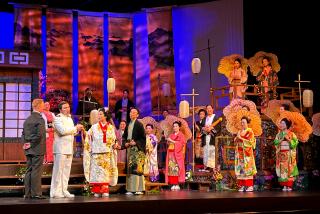Battle of Baroque bands
- Share via
THREE hours into Bach’s miraculous “St. Matthew Passion,” after a buildup no amount of treachery, anguish and gore on the silver screen could possibly equal, Jesus dies on the cross. This is a musically minor moment in a work regarded by some as the greatest spiritual document in the canon of Christian art. “And he passed away” (“und verschied”), a narrator sings in matter-of-fact recitative.
Shortly after that comes a bass aria of surpassingly sweet beauty. The text speaks of bounteous love and peace and rest, a hard day’s intoxicatingly soft night. For all its Christian symbolism, Bach’s score here seems quasi-Buddhist. Life is suffering. Death is the end of struggle.
That was certainly the message that came through Tuesday night at First United Methodist Church in Pasadena, where “St. Matthew” became a battle of the bands, Baroque style. The forces were Musica Angelica and Orchester Wiener Akademie. The former is Los Angeles’ period instrument ensemble. The latter is a Baroque group from Vienna. Martin Haselbock directs both.
The two groups are presenting the Passion on a tour that began in Mexico City last week and is to wend its way to Europe via Savannah, Ga., and New York City. The soloists will be mostly the same, the choruses different. The orchestras take turns accompanying arias and come together for the big choruses.
Bach built the competition into the score, since the chorus is often divided antiphonally for dramatic effect. Nor is it unseemly to think of Bach as competitive. He had to compete for jobs. He asked for athletic virtuosity from his performers. He expected his listeners to be trained in mental gymnastics, what with his mind-boggling counterpoint and extraordinary harmonic and rhythmic invention. Struggle in Bach is always glory.
So if the European instrumentalists and singers came out on top Tuesday, I wouldn’t put too much weight on that outcome. This “St. Matthew” is a big opportunity for Musica Angelica, and if its playing seemed more labored than that of its Viennese counterpart, the sense of exertion often fit the score’s spirit.
Nor was Haselbock’s a particularly meditative “St. Matthew.” He is fast, even for period-instrument fanciers. The instrumentalists could keep up with him, but the small chorus -- the Pacific Chorale’s John Alexander Singers -- was driven beyond its capacity and beyond the acoustic capacity of this church.
Indeed, this was a “St. Matthew” in time of war. Little of the Passion’s feminine side came through. Bach allowed room for two soprano and two alto soloists, along with the tenor and bass and an additional tenor as the Evangelist, who narrates the story of Christ’s last days, and a bass, who intones Christ’s responses. Haselbock, instead, chose a single soprano and preferred a strident male countertenor sound to the deep chocolate contralto tone so appropriate for Bach’s sad, consoling arias.
But if this was one tough-love “St. Matthew,” the countertenor, Carlos Mena, proved to be its highlight. The young Spanish singer has a concentrated tone that cut through the church with the purity of perfectly tuned organ pipes yet was ideally flexible. Most of his arias were slow, but he certainly wasn’t, embellishing all he sang with exquisite ease.
Andreas Karasiak, the Evangelist, was the other standout. He may have sung a bit on the delicate scholarly side for some, but by not bringing his own emotions to the story, the German tenor left more room for Bach’s. Christine Brandes, a full-voiced American soprano, took some time to find her way in a room too reverberant for her, but she found it. Like Brandes, Mark Bleeke (tenor), Klaus Mertens (bass) and Stephen Salters (Jesus) exhibited more vibrato than early music performance practice normally permits, and all would surely have been comfortable with slower tempos and thicker-textured accompaniment, but they sufficed.
There were things to be said for the Americans. Elizabeth Blumenstock’s violin solos were very fine. And I found Angelica’s laid-back wind playing preferable to their showier Viennese counterparts’.
In the end, Bach can withstand almost anything. The center of spiritual gravity shifts in “St. Matthew” if it flies by, as it did Tuesday, or flows like thick syrup. But musicians tend to come through. Haselbock rushed that last bass aria. Mertens got a little gooey in his phrasing. Still, at that moment, they convinced me that there could be no more meaningful music.
More to Read
The biggest entertainment stories
Get our big stories about Hollywood, film, television, music, arts, culture and more right in your inbox as soon as they publish.
You may occasionally receive promotional content from the Los Angeles Times.











